Xiao Gu
Cross-Subject and Cross-Montage EEG Transfer Learning via Individual Tangent Space Alignment and Spatial-Riemannian Feature Fusion
Aug 11, 2025Abstract:Personalised music-based interventions offer a powerful means of supporting motor rehabilitation by dynamically tailoring auditory stimuli to provide external timekeeping cues, modulate affective states, and stabilise gait patterns. Generalisable Brain-Computer Interfaces (BCIs) thus hold promise for adapting these interventions across individuals. However, inter-subject variability in EEG signals, further compounded by movement-induced artefacts and motor planning differences, hinders the generalisability of BCIs and results in lengthy calibration processes. We propose Individual Tangent Space Alignment (ITSA), a novel pre-alignment strategy incorporating subject-specific recentering, distribution matching, and supervised rotational alignment to enhance cross-subject generalisation. Our hybrid architecture fuses Regularised Common Spatial Patterns (RCSP) with Riemannian geometry in parallel and sequential configurations, improving class separability while maintaining the geometric structure of covariance matrices for robust statistical computation. Using leave-one-subject-out cross-validation, `ITSA' demonstrates significant performance improvements across subjects and conditions. The parallel fusion approach shows the greatest enhancement over its sequential counterpart, with robust performance maintained across varying data conditions and electrode configurations. The code will be made publicly available at the time of publication.
Distribution-Based Masked Medical Vision-Language Model Using Structured Reports
Jul 29, 2025Abstract:Medical image-language pre-training aims to align medical images with clinically relevant text to improve model performance on various downstream tasks. However, existing models often struggle with the variability and ambiguity inherent in medical data, limiting their ability to capture nuanced clinical information and uncertainty. This work introduces an uncertainty-aware medical image-text pre-training model that enhances generalization capabilities in medical image analysis. Building on previous methods and focusing on Chest X-Rays, our approach utilizes structured text reports generated by a large language model (LLM) to augment image data with clinically relevant context. These reports begin with a definition of the disease, followed by the `appearance' section to highlight critical regions of interest, and finally `observations' and `verdicts' that ground model predictions in clinical semantics. By modeling both inter- and intra-modal uncertainty, our framework captures the inherent ambiguity in medical images and text, yielding improved representations and performance on downstream tasks. Our model demonstrates significant advances in medical image-text pre-training, obtaining state-of-the-art performance on multiple downstream tasks.
IV-Bench: A Benchmark for Image-Grounded Video Perception and Reasoning in Multimodal LLMs
Apr 21, 2025Abstract:Existing evaluation frameworks for Multimodal Large Language Models (MLLMs) primarily focus on image reasoning or general video understanding tasks, largely overlooking the significant role of image context in video comprehension. To bridge this gap, we propose IV-Bench, the first comprehensive benchmark for evaluating Image-Grounded Video Perception and Reasoning. IV-Bench consists of 967 videos paired with 2,585 meticulously annotated image-text queries across 13 tasks (7 perception and 6 reasoning tasks) and 5 representative categories. Extensive evaluations of state-of-the-art open-source (e.g., InternVL2.5, Qwen2.5-VL) and closed-source (e.g., GPT-4o, Gemini2-Flash and Gemini2-Pro) MLLMs demonstrate that current models substantially underperform in image-grounded video Perception and Reasoning, merely achieving at most 28.9% accuracy. Further analysis reveals key factors influencing model performance on IV-Bench, including inference pattern, frame number, and resolution. Additionally, through a simple data synthesis approach, we demonstratethe challenges of IV- Bench extend beyond merely aligning the data format in the training proecss. These findings collectively provide valuable insights for future research. Our codes and data are released in https://github.com/multimodal-art-projection/IV-Bench.
Is Temporal Prompting All We Need For Limited Labeled Action Recognition?
Apr 02, 2025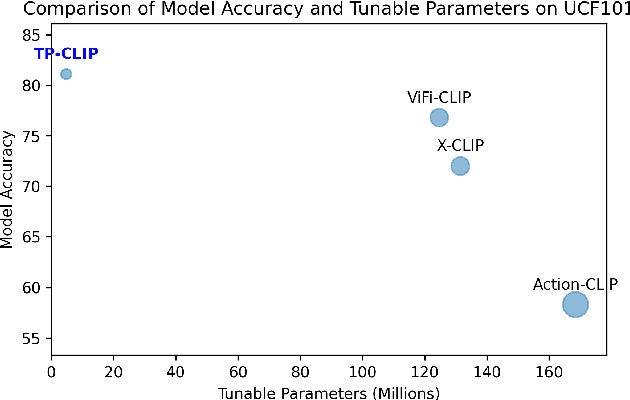
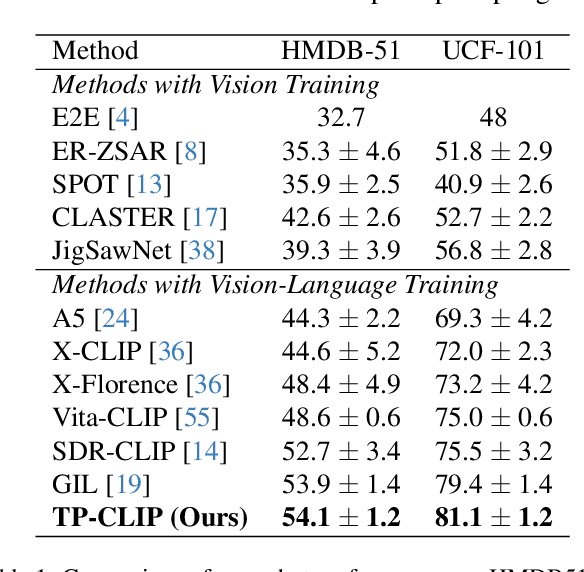
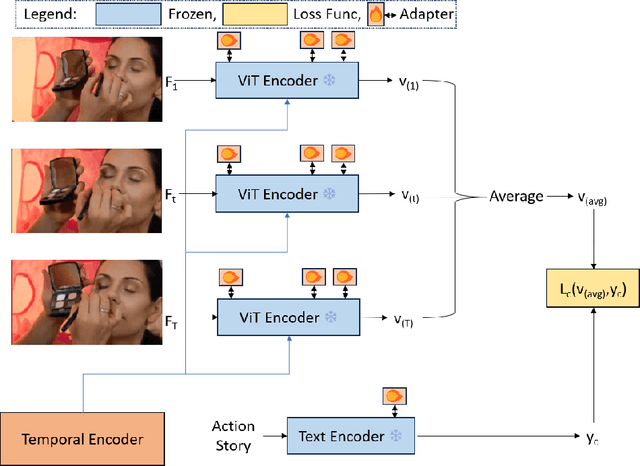
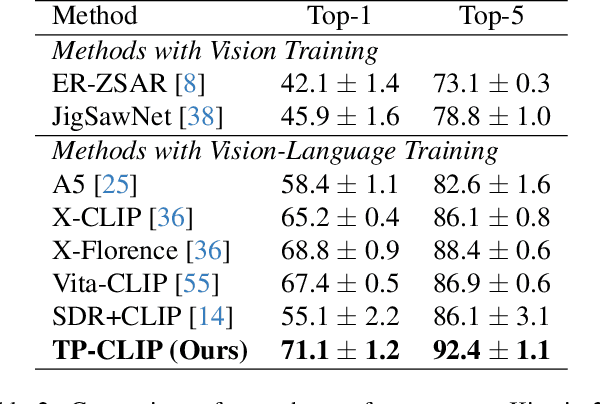
Abstract:Video understanding has shown remarkable improvements in recent years, largely dependent on the availability of large scaled labeled datasets. Recent advancements in visual-language models, especially based on contrastive pretraining, have shown remarkable generalization in zero-shot tasks, helping to overcome this dependence on labeled datasets. Adaptations of such models for videos, typically involve modifying the architecture of vision-language models to cater to video data. However, this is not trivial, since such adaptations are mostly computationally intensive and struggle with temporal modeling. We present TP-CLIP, an adaptation of CLIP that leverages temporal visual prompting for temporal adaptation without modifying the core CLIP architecture. This preserves its generalization abilities. TP-CLIP efficiently integrates into the CLIP architecture, leveraging its pre-trained capabilities for video data. Extensive experiments across various datasets demonstrate its efficacy in zero-shot and few-shot learning, outperforming existing approaches with fewer parameters and computational efficiency. In particular, we use just 1/3 the GFLOPs and 1/28 the number of tuneable parameters in comparison to recent state-of-the-art and still outperform it by up to 15.8% depending on the task and dataset.
RiskAgent: Autonomous Medical AI Copilot for Generalist Risk Prediction
Mar 05, 2025Abstract:The application of Large Language Models (LLMs) to various clinical applications has attracted growing research attention. However, real-world clinical decision-making differs significantly from the standardized, exam-style scenarios commonly used in current efforts. In this paper, we present the RiskAgent system to perform a broad range of medical risk predictions, covering over 387 risk scenarios across diverse complex diseases, e.g., cardiovascular disease and cancer. RiskAgent is designed to collaborate with hundreds of clinical decision tools, i.e., risk calculators and scoring systems that are supported by evidence-based medicine. To evaluate our method, we have built the first benchmark MedRisk specialized for risk prediction, including 12,352 questions spanning 154 diseases, 86 symptoms, 50 specialties, and 24 organ systems. The results show that our RiskAgent, with 8 billion model parameters, achieves 76.33% accuracy, outperforming the most recent commercial LLMs, o1, o3-mini, and GPT-4.5, and doubling the 38.39% accuracy of GPT-4o. On rare diseases, e.g., Idiopathic Pulmonary Fibrosis (IPF), RiskAgent outperforms o1 and GPT-4.5 by 27.27% and 45.46% accuracy, respectively. Finally, we further conduct a generalization evaluation on an external evidence-based diagnosis benchmark and show that our RiskAgent achieves the best results. These encouraging results demonstrate the great potential of our solution for diverse diagnosis domains. To improve the adaptability of our model in different scenarios, we have built and open-sourced a family of models ranging from 1 billion to 70 billion parameters. Our code, data, and models are all available at https://github.com/AI-in-Health/RiskAgent.
Learning Semi-Supervised Medical Image Segmentation from Spatial Registration
Sep 16, 2024



Abstract:Semi-supervised medical image segmentation has shown promise in training models with limited labeled data and abundant unlabeled data. However, state-of-the-art methods ignore a potentially valuable source of unsupervised semantic information -- spatial registration transforms between image volumes. To address this, we propose CCT-R, a contrastive cross-teaching framework incorporating registration information. To leverage the semantic information available in registrations between volume pairs, CCT-R incorporates two proposed modules: Registration Supervision Loss (RSL) and Registration-Enhanced Positive Sampling (REPS). The RSL leverages segmentation knowledge derived from transforms between labeled and unlabeled volume pairs, providing an additional source of pseudo-labels. REPS enhances contrastive learning by identifying anatomically-corresponding positives across volumes using registration transforms. Experimental results on two challenging medical segmentation benchmarks demonstrate the effectiveness and superiority of CCT-R across various semi-supervised settings, with as few as one labeled case. Our code is available at https://github.com/kathyliu579/ContrastiveCross-teachingWithRegistration.
Multi-Scale Cross Contrastive Learning for Semi-Supervised Medical Image Segmentation
Jun 25, 2023Abstract:Semi-supervised learning has demonstrated great potential in medical image segmentation by utilizing knowledge from unlabeled data. However, most existing approaches do not explicitly capture high-level semantic relations between distant regions, which limits their performance. In this paper, we focus on representation learning for semi-supervised learning, by developing a novel Multi-Scale Cross Supervised Contrastive Learning (MCSC) framework, to segment structures in medical images. We jointly train CNN and Transformer models, regularising their features to be semantically consistent across different scales. Our approach contrasts multi-scale features based on ground-truth and cross-predicted labels, in order to extract robust feature representations that reflect intra- and inter-slice relationships across the whole dataset. To tackle class imbalance, we take into account the prevalence of each class to guide contrastive learning and ensure that features adequately capture infrequent classes. Extensive experiments on two multi-structure medical segmentation datasets demonstrate the effectiveness of MCSC. It not only outperforms state-of-the-art semi-supervised methods by more than 3.0% in Dice, but also greatly reduces the performance gap with fully supervised methods.
Revisiting Self-Supervised Contrastive Learning for Facial Expression Recognition
Oct 08, 2022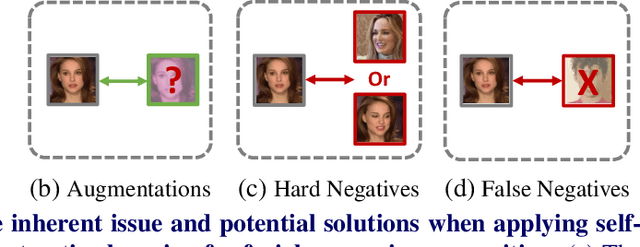
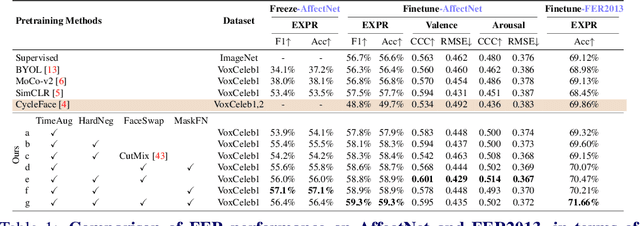
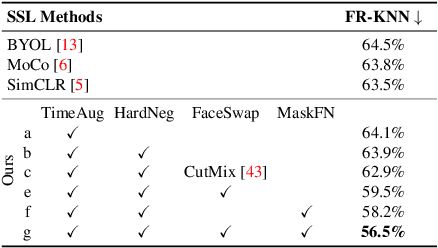
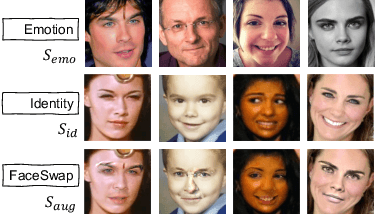
Abstract:The success of most advanced facial expression recognition works relies heavily on large-scale annotated datasets. However, it poses great challenges in acquiring clean and consistent annotations for facial expression datasets. On the other hand, self-supervised contrastive learning has gained great popularity due to its simple yet effective instance discrimination training strategy, which can potentially circumvent the annotation issue. Nevertheless, there remain inherent disadvantages of instance-level discrimination, which are even more challenging when faced with complicated facial representations. In this paper, we revisit the use of self-supervised contrastive learning and explore three core strategies to enforce expression-specific representations and to minimize the interference from other facial attributes, such as identity and face styling. Experimental results show that our proposed method outperforms the current state-of-the-art self-supervised learning methods, in terms of both categorical and dimensional facial expression recognition tasks.
Clustering Egocentric Images in Passive Dietary Monitoring with Self-Supervised Learning
Aug 25, 2022
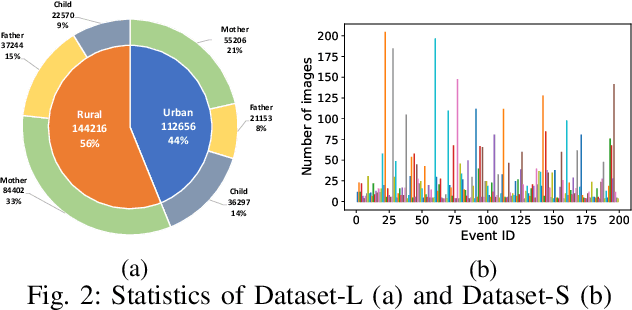

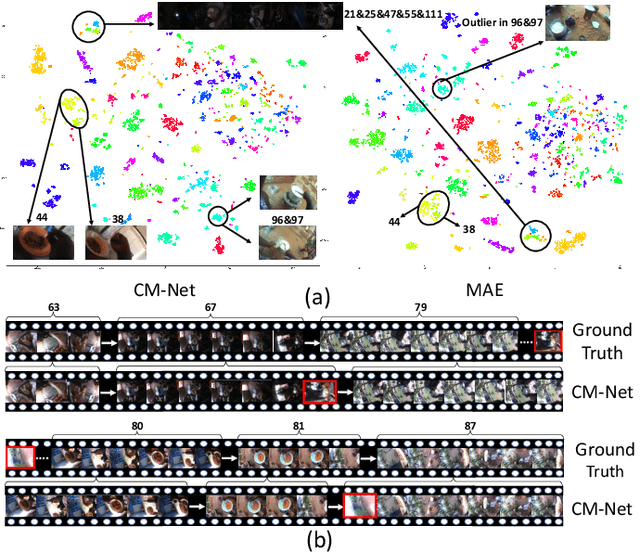
Abstract:In our recent dietary assessment field studies on passive dietary monitoring in Ghana, we have collected over 250k in-the-wild images. The dataset is an ongoing effort to facilitate accurate measurement of individual food and nutrient intake in low and middle income countries with passive monitoring camera technologies. The current dataset involves 20 households (74 subjects) from both the rural and urban regions of Ghana, and two different types of wearable cameras were used in the studies. Once initiated, wearable cameras continuously capture subjects' activities, which yield massive amounts of data to be cleaned and annotated before analysis is conducted. To ease the data post-processing and annotation tasks, we propose a novel self-supervised learning framework to cluster the large volume of egocentric images into separate events. Each event consists of a sequence of temporally continuous and contextually similar images. By clustering images into separate events, annotators and dietitians can examine and analyze the data more efficiently and facilitate the subsequent dietary assessment processes. Validated on a held-out test set with ground truth labels, the proposed framework outperforms baselines in terms of clustering quality and classification accuracy.
Neural Message Passing for Visual Relationship Detection
Aug 08, 2022
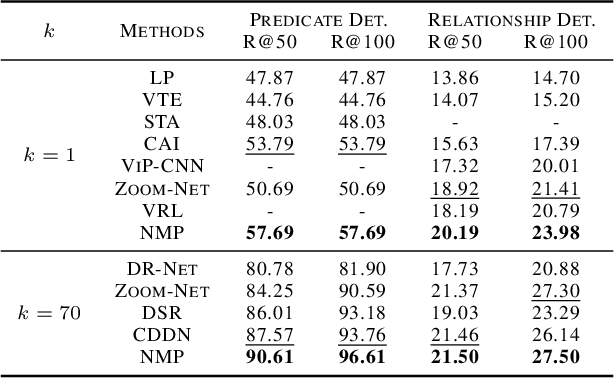


Abstract:Visual relationship detection aims to detect the interactions between objects in an image; however, this task suffers from combinatorial explosion due to the variety of objects and interactions. Since the interactions associated with the same object are dependent, we explore the dependency of interactions to reduce the search space. We explicitly model objects and interactions by an interaction graph and then propose a message-passing-style algorithm to propagate the contextual information. We thus call the proposed method neural message passing (NMP). We further integrate language priors and spatial cues to rule out unrealistic interactions and capture spatial interactions. Experimental results on two benchmark datasets demonstrate the superiority of our proposed method. Our code is available at https://github.com/PhyllisH/NMP.
 Add to Chrome
Add to Chrome Add to Firefox
Add to Firefox Add to Edge
Add to Edge